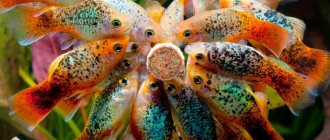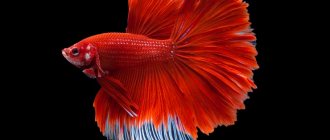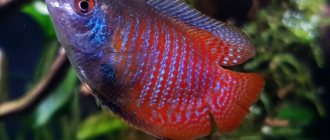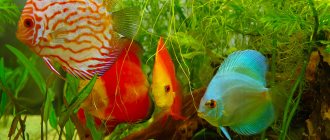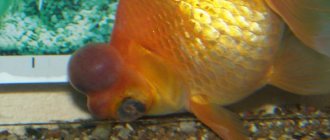Simplicity of content:
Latin name: Xiphophorus maculatus
Lifespan: 4 years
Maximum size: 5 cm.
Average cost: 70-160 rubles.
The aquarium platie fish is one of the most common and sought-after species, as it is distinguished by its unpretentiousness and visual attractiveness. The variety of colors allows you to get a spectacular species aquarium, in which it will be extremely easy to provide comfortable living conditions for your pets. The small size of platies allows them to be kept even in small containers, which is a plus for residents of small apartments.
Motherland
The homeland of platies is America, where they live in the lower reaches of rivers flowing into the Atlantic Ocean. Under natural conditions, these schooling fish have a color ranging from yellowish-gray to spotted. It cannot be called very attractive, and today's bright fish are the result of the work of breeders.
Wild platies have a spotted color, which allows them not to stand out against the background of water and plants. Blue platies (pictured) will not go unnoticed!
Platies grow in nature up to 18 cm, and aquarium forms do not exceed 5 cm in length. Their body is shortened, resembling a diamond, with a fairly wide caudal fin. The head is proportional to the body, with large eyes. The mouth is directed upward. The movements of the fish are moderately fast, smooth, and not jerky.
To live in nature, fish choose places with dense thickets of aquatic plants, where they can hide from predators. The diet consists of algae and insects, as well as small aquatic invertebrates that do not have a strong shell.
These fish were brought to Europe late - only in the 20th century. They were brought from Mexico and Guatemala. The species was first described in 1886. In the USA, the species quickly attracted the attention of breeders, who, through their efforts, were able to obtain from a rather inconspicuous wild fish spectacular inhabitants for home ponds with colors ranging from red to blue, distinguished by their hardiness and even forgiving beginners many mistakes in caring for an aquarium. Platies are peaceful and can get along well with a large number of other fish species.
Description
Platies are small fish, their body length can reach 5 cm. They live for about 3-4 years, provided optimal conditions are created for them. As for the color and appearance in general, it is impossible to describe everything - there are more than 30 species of these fish, and more than 120 color options.
The aquarium fish platylon balloon deserves special attention. This is a selective species, unlike other platies. Their body is round, swollen, which was obtained in the process of crossing with fish with a short spine. The fry are born with a normal spine, but during growth it becomes deformed. These fish are more capricious compared to other species.
The most common species is the red platie - these fish are unpretentious. Many breeding forms were created on their basis. Slightly less known are black platies, with bluish or greenish scales. Multi-colored platies are incredibly beautiful - their body shimmers with all the colors of the rainbow.
The disc platy has a shortened and flattened body. These fish were also obtained through crossing.
Origin story
Platies are the name given to a number of fish species that belong to the carp-toothed family. Aquarists around the world favor platies, however, in most cases they call them “mollies.” At the very beginning, this term referred only to melanistic forms of platies, but later the entire series of platies species began to be called in this way.
Just like guppies, platies are often bred. By the way, these fish appeared in Europe back in 1907, due to the fact that they were brought from Guatemala and Southern Mexico. In the wild, platies live in the lower reaches of rivers that flow into the Atlantic Ocean. However, the coloring of fish in their natural environment is much less attractive than that which is typical for the inhabitants of domestic ponds. Often the fish are distinguished by a brownish-yellow color, which is slightly enlivened by a couple of dark spots located in front of the caudal fin. Today, the results of many years of breeding have proven that platies, while maintaining their shape, have a wide variety of colors.
Like almost all viviparous species, platies are extremely unpretentious and easy-going. They can be kept in small aquariums, from 40-50 liters, but larger is better. They do not show aggression among themselves (unlike swordtails), and they can be kept with a predominance of females. One male is enough for two or three females.
Water parameters are not too important, water of medium hardness will be ideal (15 - 30 dGH), acidity within ph: 7.0-8.3, and water temperature 22-25 C. It is important that the water is clean and fresh, it is advisable to change part of the water weekly ( up to 20%). Filtration and aeration are desirable, but if the aquarium is not overcrowded, then it can be neglected.
Characteristic
Platies are warm-water fish. The coloring of aquarium species of platies, thanks to many years of selection and comfortable conditions of detention, is distinguished by brightness, richness and a greater variety of colors than that of the ancestors of fish of this genus. Their wild relatives are brownish-yellow in color, with two prominent dark spots in front of the caudal fin.
Fish of the platie genus are small in size: the body length of males is less than that of females - from 3 to 4 cm and from 4 to 6 cm, respectively. The body is quite dense, strong, the caudal fin is wide and strong, although as a result of selection experiments, individuals with various shapes of the body and fins were bred. For adult males, in addition to their size and slimmer body, a characteristic feature is the copulatory organ (gonopodium) - an anal fin rolled into a tube.
Description and characteristics
If you look at a photo of a wild platy, you won’t see much decorativeness. The natural color of the fish is quite modest : brown spots are scattered throughout the pale yellow body.
For the versatility and brightness of colors, we should thank the breeders who worked hard on the appearance of platies.
The body length of the fish varies from 3 to 12 cm . All species are viviparous.
Although radically different in color, they are all similar in care and behavior. Pecilia variatus lives 3–5 years.
Motherland
The homeland of platies is America, where they live in the lower reaches of rivers flowing into the Atlantic Ocean. Under natural conditions, these schooling fish have a color ranging from yellowish-gray to spotted. It cannot be called very attractive, and today's bright fish are the result of the work of breeders.
Wild platies have a spotted color, which allows them not to stand out against the background of water and plants. Blue platies (pictured) will not go unnoticed!
Platies grow in nature up to 18 cm, and aquarium forms do not exceed 5 cm in length. Their body is shortened, resembling a diamond, with a fairly wide caudal fin. The head is proportional to the body, with large eyes. The mouth is directed upward. The movements of the fish are moderately fast, smooth, and not jerky.
To live in nature, fish choose places with dense thickets of aquatic plants, where they can hide from predators. The diet consists of algae and insects, as well as small aquatic invertebrates that do not have a strong shell.
These fish were brought to Europe late - only in the 20th century. They were brought from Mexico and Guatemala. The species was first described in 1886. In the USA, the species quickly attracted the attention of breeders, who, through their efforts, were able to obtain from a rather inconspicuous wild fish spectacular inhabitants for home ponds with colors ranging from red to blue, distinguished by their hardiness and even forgiving beginners many mistakes in caring for an aquarium. Platies are peaceful and can get along well with a large number of other fish species.
Types of platies
The determination of breeders in creating new varieties of platies has led to the fact that today there are 130 of its subspecies .
Among fans of this fish, 17 of them are the most popular . Let's take a closer look at these amazing beauties.
Pecilia white
White platies are rarely found on sale, since during the breeding process the offspring do not inherit the phenotype of the parents.
The lack of color is due to the switching off of genes that form skin pigmentation. The fish is not just white: it is almost transparent, through its scales you can see the internal organs.
Blue or neon platylia is not as rare as white platylia, but it is not easy to buy either.
In addition to the pleasant blue tint, the scales of the fish shimmer with neon light, enhancing its decorative appearance.
High fin
This species was obtained by crossing the common platie and the flag swordtail.
The main feature of the fish is its highly protruding dorsal fin. Various variations are possible in color.
Hawaiian
The Hawaiian Plaie was developed in 1962. The body of the fish can be painted black or yellow, and the tail of all varieties is red. The fins can be yellow or transparent.
Balloon
Unlike the slender forms of other members of the family, the balloon looks like a ball with a tail and head.
It looks exotic and even ugly, but the abundance of colors compensates for the strange shape of the fish.
Interesting! Balloon fry are born with a straight spine, but during growth it bends, giving the fish a rounded shape. You need to move sedentary neighbors to the cylinder: he himself floats rather awkwardly.
Radish
Brought out in the 70s of the last century. The classic color is a red body and a black tail, but there are other variations. A distinctive detail of the appearance is the diamond-shaped tail.
Black
There is no absolute blackness, as is the case with mollies, in the color of platies. She has a black color complemented by red, orange and various light shades of fins and tail.
Tricolor
The three-color color of platies consists of several combinations: blue with yellow-green and black with yellow and orange.
The distribution of colors is unpredictable and does not have clear boundaries. The length of the fish is 7 cm.
Important! She loves dense thickets of plants, where she hides from enemies and retires to think.
Sailing velifera
A variety of high-finned platies, in which the fin is transformed into a wide sail, proudly fluttering over the back.
The body color is represented in several shades: yellow, chocolate, silver. A very active fish, but if it lies on the bottom, it means your pet has health problems.
Spotted
In color and size, the spotted species is not far from the parameters of wild platies.
However, through the efforts of breeders, it acquired an orange tint to the body, with dark spots scattered throughout it. Prefers a spacious aquarium where it can frolic freely.
Interesting! The Riga platie also has spotting, with dark spots of varying sizes running along its bright orange body.
Disk
The main feature of the species is the discoid body. The fish are small in size, no more than 3 cm in length, while females are noticeably larger than males.
The main body color is red; the fins can be colored black or red. Pecilia discus, like the balloon, is born with a straight spine.
Microplates, or Brunner's platies, also have the same size. They swim in schools and have variable colors.
Yellow
Yellow platylia is a large representative of the genus. The body length of individuals can reach 10 cm.
The sunny shades of the main color are beautifully diluted with scarlet fins.
Neon
The rainbow or neon variety leads a gregarious lifestyle. The predominant colors in the body color are blue or blue.
The fins have dark shades. The neon effect manifests itself in the glow of the scales at different lighting angles.
Black-tailed
The black-tailed species has given birth to many selective varieties of platies. The body length of the fish is 12 cm. It is classically colored: the body is red and the fins are black.
Both colors are rich and deep. To maintain its spectacular color, the fish are fed only live food.
Mickey Mouse
Breeders bred a fish with an unusual color, and, seeing what they got, they named it Mickey Mouse.
And indeed: closer to the tail we clearly see the face of the famous cartoon character, made up of one large and two small black spots.
The basic body tone varies from gold to blue.
Sunset
Sunset, or calico platie, is rarely sold in pet stores. A fish with an original pattern, in which the yellow tone smoothly turns into red.
The calico print is marked by dark spots on the sides and a black border of red and yellow fins. Males, as a rule, are brighter colored than females.
Tuxedo
Tuxedo has a noble coloring, in which the silver on the back and belly flows harmoniously into the deep blue of the sides. These are large fish with a body length of up to 10 cm.
Reds
A true red platie is a fish in which all parts of the color are painted in the dominant color.
Sometimes the fins can be transparent. Individuals with a red body and black fins are a different species.
This is interesting! Thanks to the selection of red platies, scientists obtained red swordtails, which in nature are always colored green.
Differences between platies and mollies
All subspecies of platies and molly have a fairly similar appearance. Thus, mollies have a more elegant and toned body, and the distance from the anus to the caudal fin is greater. There are not as many color options as there are for platies - usually black and gold mollies are on sale, and in rare cases white.
Molly is more graceful.
Platies are calmer and do not get into fights with their neighbors. This can also be regarded as a distinctive feature. Their faces have different expressions - molly's is more aggressive.
When starting an aquarium, you can safely choose any poeciliids as your first pets. They are distinguished by good health, endurance and will survive even some deviations from ideal conditions. In addition, they reproduce easily, they can live in a home pond from generation to generation, and the peaceful nature of these fish allows them to be introduced to attractive neighbors and some other species.
Compatibility
They can easily make friends with tetras, rainbows, cardinals, neons, gouramis, and catfish. But close relatives will be ideal neighbors for platies:
- swordtails;
- mollies;
- guppy
Keeping peaceful and defenseless platies with large predators and other aggressive species such as barbs, cichlids, cockerels, and astronotuses is contraindicated.
Reviews
I love platies for their peaceful nature and variety of colors. The nimble fish are not difficult to care for. I started them as my first inhabitants of the aquarium and have been faithful to them for 5 years. Elena, 40 years old, Tula
The child had been asking for an aquarium for a long time, and when they decided, they set up a 60-liter container and introduced 8 platies (4 red and 4 spotted). No one had ever kept fish before. It turned out to be not difficult - just change the water regularly and feed it. In the year we’ve been keeping them, we’ve already managed to get fry several times. Beautiful and simple fish. Nikolay, 30 years old, Moscow
Content
If you want to provide your platies with proper maintenance and care, house the fish in schools.
Only in the society of their own kind do they feel protected, actively develop and live in harmony. The main thing is to create a comfortable environment for pets .
Content Options
When organizing a water dwelling for platies, the temperature in it is maintained at around 20…25 °C. Water hardness is 8–25 dH, acidity is 7.5–8 pH.
It is advisable to change water every week in a volume of 1/3 of the total amount. Aeration and light should be moderate.
View this post on Instagram
Posted by Fifty Fish (@_fifty_fish_) May 25, 2021 at 10:23 am PDT
Arrangement of the aquarium
For platies that lead a gregarious lifestyle, a capacious tank is needed . For 5-6 fish you will need at least 60 liters.
Small pebbles or river sand in dark colors are suitable as soil.
The vegetation is dense, but planted along the back wall of the aquarium . Platies need to be given free space to swim. An excellent green zone will consist of:
- Vallisneria;
- hornwort;
- elodea;
- Echinodorus.
For decoration, you can use large round stones or driftwood.
Nutrition
Platies are fed with regular food ( tubifex, daphnia, rotifers, bloodworms ), adding plant foods to the diet.
Feeding frequency: 2 times a day. The portion should be such that the fish eat everything in 10 minutes.
Attention! To improve the health of pets and prevent obesity, once a week they are given a fasting day.
Habitat
It was originally considered endemic to small, heavily overgrown bodies of water on the Atlantic slope of Mexico. However, with the development of aquarium farming, these fish found themselves in a new habitat, where they successfully took root.
The habitat has expanded throughout Central America, the Caribbean islands, and the southern states of the United States. They now inhabit river systems in Southeast Asia, the Far East and southern regions of Europe.
Brief information:
- Aquarium volume - from 60 liters.
- Temperature - 20–28°C
- pH value – 7.0–8.2
- Water hardness - medium to high hardness (10–30 dGH)
- Substrate type - any
- Lighting – moderate or bright
- Brackish water - acceptable in a concentration of 5–10 g per liter of water
- Water movement - moderate
- The size of the fish is 5–7 cm.
- Food - any food
- Temperament - peaceful
- Living alone, in pairs or in a group
Reproduction
When breeding platies, special attention from the owner is required to care for the fry .
Viviparous fish themselves cope with their birth, but feeding and maintaining the young falls on the shoulders of the pet owner.
Differences between a male and a female
In a flock of pets, it is easy to distinguish a female from a male. It is noticeably larger and has a more rounded body, but is paler in color.
Its anal fin is larger, and in the male it combines two functions - gonopodium and the fin itself.
Spawning
If you want to see how platies give birth, prepare a small spawning area for them. Place one male and three females in it.
After some time, they will all be fertilized by the male. It will take 28 days for the fry to form in the mother's abdomen .
The male is removed, but the females can be left in the spawning tank. A successful pregnancy of a female can be recognized by the rounding of the abdomen and the appearance of a dark dot at the anal fin.
Closer to birth, the spawning area should be covered with a cloth to provide the fish with a calm environment. The fry are born physically formed and ready to swim independently .
Fry
After the fry are born, the mother is removed. At the initial stage of growth, the juveniles are fed boiled yolk and crushed daphnia.
After 1.5–2 weeks, they are switched to adult food. They are kept in a spawning tank until they are three months old , providing the necessary care for the reservoir.
Adviсe
- If overfeeding occurs, immediately remove excess food from the aquarium with a net.
- When purchasing fish food, carefully study the expiration date and storage conditions. Avoid loose feed.
- When breeding fish, select fish of the same variety, so the offspring will be purebred.
- When spawning, remember that a lot of offspring appear. Make sure you have a large aquarium.
- When buying pets in a store, carefully inspect the fish. She should not show signs of illness.
- New fish should be introduced into the aquarium gradually. First, place the bag in the aquarium for half an hour, then pour some aquarium water into the shipping bag. Gradually add aquarium water.
Pecilia is a beautiful and unpretentious fish that is perfect for beginners. An interesting feature: if the conditions of detention change sharply, the fish changes sex. Thus, the female becomes a male.
Previous
FishFire barb - a fish for beginners
Next
FishIs it possible to have a fish like a blue dolphin in an aquarium?
Diseases
Possessing good immunity, platies rarely get sick. However, violations in maintenance parameters can lead to infection of fish by parasites and fungi.
Fin rot
A dangerous disease that begins with damage to the fins and spreads its negative impact to the internal organs of the fish. External signs of rot:
- fins sticking together;
- gray ulcers;
- tissue necrosis.
The main prevention of the disease is careful adherence to sanitary standards.
Ichthyophthiriasis (semolina)
The infection is marked by a small white rash on the body , similar to semolina. Often enters ponds with dirty food. Successfully cured with malachite greens.
Nematodes
Worms rarely affect platies , but to avoid infection, antiseptics should be regularly added to the water, observing the required dosage.
Feeding
The main diet that will allow the fish to remain alive and active can be dry food. You can choose ones that are designed to maintain color.
But if the goal is to create a real paradise, then it is worth feeding with other foods. First of all, live or frozen bloodworms, tubifex. It is a source of living protein, which means good disease resistance and bright coloring. Vitamins can be prepared from nettles: steamed and finely grated.
The main thing is to remember that in a small aquarium feeding should be done with special care. Any food in excess will quickly spoil the water. It is better to remove uneaten particles of dry flakes, granules, and even more so, the remains of bloodworms and nettles immediately. Platies fish, having an upper mouth, are unlikely to collect food from the bottom. After lying in warm water for a while (an hour or two), it will completely become inedible biological waste. Therefore, feeding should be moderate, so that in 5-7 minutes the fish eat everything without a trace.
Spawning
In platies, reproduction begins with mating. The male chases the female until she gives up. Then the male fish plunges the gonopodium into the partner’s genital opening and injects milk. The eggs are fertilized inside the female's body.
A special feature of the female species is the ability to store milk in the body for a long time. The fish resorts to this method during periods unfavorable for the birth of offspring in order to wait for better conditions.
After mating, the pregnant female remains in the spawning area, the male returns to the common home.
Diseases
With good care, a balanced diet and proper maintenance, diseases of the platie are rarely bothered, otherwise the pets may develop diseases characteristic of the genus:
- Melanosis is a disease that occurs due to a malfunction in the fish’s body when there is a high production of melanin. Symptoms appear as spots on the body, which over time develop into lumps or lumps. Sick fish are moved to quarantine tanks, where they follow a strict regime.
- Tumors are a collection of bacteria on the body of the phenotype that look like lumps. Pets are treated with saline solution: 20 g of salt per liter of liquid. Sick fish are dipped in the solution and kept for ten minutes, after which they are placed in a separate tank until the signs of the disease disappear.
- Dark blisters are a characteristic ailment for phenotypes, accompanied by the appearance of dark-colored blisters on the body. To cure a pet, the fish is treated with the antiseptic Tripaflavin, followed by a stay in quarantine until the disease subsides.
Platies are friendly aquarium fish that have conquered the world thanks to the abundance of varieties of different shapes and colors. Care and maintenance do not require much effort and time, and the pets themselves have funny behavior, are active and hardy, and also look great in artificial reservoirs among green, dense vegetation.
Creating conditions for spawning
Successful propagation at home does not require special preparation. It is enough to create favorable conditions in the aquarium, and the reproduction of fish will be active.
There are two ways to breed platies: either in a general aquarium or in a spawning tank with a capacity of about 20 liters. In the second case, the fry will develop calmly, protected from attack by adult fish, including their parents. And in the common reservoir natural selection operates. The percentage of survivors will be low. And even then, if there are no aggressive species in the home tank. Otherwise they will eat everyone.
In preparation for spawning, fill the spawning tank with water from the main tank, to which the fish are adapted. Otherwise, breeding and transportation will become seriously stressful for the platies.
To make breeding comfortable for platies, provide aeration and filtration. Make the lighting dim, and place floating vegetation on the surface of the water in which the newborn fry will hide. Soil is not needed in the spawning tank; it will only worsen the water quality. It is better to put Java moss on the bottom. The optimal water temperature is about 25°C.


